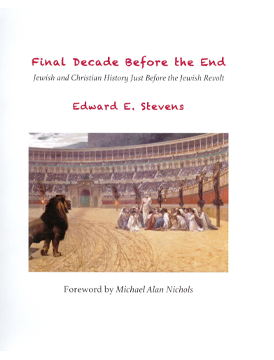One Column Page
and responsive to boot
Nero Died - Vespasian Succeeded
by Edward E. Stevens
This article appeared in the 2022 Winter issue of Fulfilled! Magazine

One of the benefits of studying first-century history is a better understanding of the book of Revelation. We simply lay the history down beside the Apocalypse and connect the dots. We will do some of that here as we go through this series of studies. If you notice any connections that we missed, be sure to share those with this author.
We noted in our previous article that by the end of Spring (late May of 68), Vespasian had subdued all of Galilee, Samaria, Decapolis, Perea, western Judea, and Idumea, and was preparing to attack Judea and Jerusalem when he heard that Nero died. He immediately suspended operations until he could learn more about the situation in Rome [War 4.491 (4.9.1)].
Death of Nero
June 9, 68 – When Nero realized that Galba’s conspiracy against him had succeeded, he fled from Rome to his friend Phaon about four miles away. There he heard about the Senate’s decree against him, and that Galba was the new emperor. After several hours of sheer terror contemplating what the soldiers would do to him, he stabbed himself in the throat with the help of his friend Epaphroditus just as the soldiers were approaching (Nero Reality and Legend, Warmington, pp. 162-163).
Nero died childless, last of the Julio-Claudian dynasty to rule over Rome. Nero had already killed all of the other family members who were in a position to claim the throne, leaving no children or close relatives to perpetuate the Julio-Claudian rule of Rome. This forced the Romans to find a new emperor from a different family line.
Three contenders for the throne followed in quick succession before Vespasian was finally proclaimed emperor. Galba reigned six months before he was assassinated (Jan. 15, AD 69). Otho only reigned three months before he was killed (April 15, AD 69). And Vitellius’ forces were constantly challenged by armies allied with Vespasian [War 4.586 (4.10.1)].
Winter 69 – Factions in Jerusalem. The Zealots saw all this confusion, delay, and leadership struggle in Rome as a sign from God that victory would be theirs. Nero was dead with no firm successor in place. Some western nations of the empire were on the edge of revolt, and the city of Rome was embroiled in civil strife. It seemed to them that the time of freedom and independence for Judea had arrived. But it was only a delusion.
During the Winter and early Spring (AD 69), the Zealot factions in Jerusalem struggled against each other for supremacy. Because each of the faction leaders wanted to be at the top after the Romans were defeated, they weakened themselves by fighting each other at a time when they should have united.
John of Gischala used the Winter to gain control of most of the Zealot forces in Jerusalem, and was allied with Eleazar b. Ananias, whose soldiers controlled the inner temple. John controlled the rest of the city. His soldiers dressed themselves as women and behaved like prostitutes and sodomites. Josephus was enraged at this perverse violation of biblical law. Deuteronomy 22:5 condemns it and calls it an abomination. The Zealots proved themselves to be totally lawless [War 4.561-563 (4.9.10) cf. Antiq. 4.301 (4.8.43)].
And their lawless conduct was committed against their own Jewish people, especially those who would not support their war effort. Josephus says the robbers, Sicarii, Zealots, seditious factions, and even the Priests kept laws only selectively, if at all [Antiq. 20:200-203 (20.9.1); War 7.253-273 (7.8.1); War 4.556-563 (4.9.10); and War 4.184 (4.3.10)]. Jesus had predicted such a time as this when “lawlessness is increased” (Matt 24:12).
Spring 69 – The Idumeans who were inside Jerusalem despised John of Gischala, banded together against him, and tried to isolate him in the Palace and the outer Temple, seizing some of his supplies. But the rest of the Zealots came to his aid [War 4.566-570 (4.9.11)]. The chief priests under Matthias (former High Priest), along with the powerful moderates, had allied themselves with the Idumeans in an attempt to overthrow John. When that failed, they invited Simon b. Giora into the city to save them from John of Gischala, not realizing that Simon was just as corrupt as John [War 4.571-576 (4.9.11)].
Spring 69 – After Simon b. Giora entered Jerusalem, he soon gained control of the Zealot supplies, and surrounded John’s forces at the Temple [War 4.577 (4.9.12)]. However, John’s men were able to repulse Simon’s soldiers and retain control of the outer temple area [War 4.578-584 (4.9.12)].
And since Eleazar b. Ananias was still in control of the inner temple, the arrival of Simon b. Giora brought a third faction onto the scene. But this internecine struggle between the three Zealot leaders only weakened their defenses and made it easier for the Romans to overcome them.
Many of the statements in Josephus about the wickedness of the Zealots and their factional rivalry are strikingly similar to the prophecies in both Daniel and Revelation. For instance, Revelation 16:19 states that “the great city was split into three parts.”
Spring 69 – Vespasian resumed military activities in the Spring, and by June of 69 he had regained control of all Palestine except Jerusalem and the three Herodian strongholds (Masada, Herodium, and Machaerus). All of the rebels were now confined in Jerusalem and those three fortresses.
June 69 – Vespasian had heard about the death of Galba and Otho by this time and knew that the situation in Rome was unstable. Therefore, he wanted to wrap up the war in Judea as quickly as possible. He took some of his soldiers out of Caesarea and seized the Acrabattene toparchy that Simon b. Giora had formerly controlled. Since Simon was now preoccupied inside Jerusalem, he could not leave to protect that territory. Vespasian continued tightening his grip on all regions outside Jerusalem, forcing all rebels to flee to Jerusalem, where he could ultimately make his final assault [War 4.549-555 (4.9.9)].
Vespasian Became Emperor
Jul 30, 69 – Vespasian was proclaimed emperor on July 30 AD 69 by his legions in Caesarea while Vitellius was still alive, a little more than a year after Nero’s death [War 4.588 (4.10.2)]. The troops in Syria and Egypt likewise wasted no time in affirming Vespasian as emperor soon after they heard about the proclamation in Caesarea [War 4.601-621 (4.10.4-6)]. They all believed that Vespasian could restore stability to the empire.
Aug 69 – Vespasian gave his son Titus command of the legions to continue the war and raise the siege on Jerusalem [War 4.655-663 (4.11.4)]. He then went to Antioch to dispatch Mucianus and his large force to march overland to Dyrrhachium (Durres, Albania) where a fleet of ships was waiting to carry them across the Adriatic to fight Vitellius’ army in Rome [War 4.630-633 (4.11.1)].
Aug 69 – About this same time, the Danubian armies declared their allegiance to Vespasian. Their commander, Antonius Primus, took five legions and crossed into Italy where he defeated the main Vitellian forces at Cremona and burned the city. Then his army headed toward Rome and entered the city on Dec 20th or 21st.
Nov–Dec, 69 – Civil war in Italy. The armies in Europe split into two opposing factions, one for Vitellius, and the other for Vespasian. However, the forces of Vespasian were stronger and soon overcame the armies of Vitellius.
Dec 21, 69 – Vitellius was killed. The Roman senate then officially confirmed Vespasian as the new emperor. On the next day, Mucianus and his army arrived in Rome, and set up a temporary government until Vespasian could arrive.
Dec 69 – Vespasian stayed in Antioch until December, then sailed to Alexandria (Egypt). When he arrived, he heard about the death of Vitellius and the senate’s confirmation. The whole city celebrated with him. Since Egypt was the main source of grain for Rome, it was crucial that the emperor maintain very good relations with the Egyptians. Vespasian stayed in Alexandria during the winter from late Dec 69 until it was safe to sail to Rome in the spring of 70.
In addition to Josephus’ prediction two years earlier (AD 67) that Vespasian was destined to become emperor, Vespasian encountered many other favorable omens during his career that pointed in the same direction. For example, see Tacitus, Hist. 2.78; Suetonius, Vesp. 5; Dio Cassius 66.1. For many more details about Vespasian, see Wikipedia: https://en.wikipedia.org/wiki/Vespasian
Winter 70 – Titus remained with his troops in Judea during the winter, planning their attack on Jerusalem in the early Spring. In our next article we will look at the activities of the Zealots during the winter of 70, as well as the beginning of the siege of Jerusalem by Titus in the Spring of 70. Since many of these events seem to be alluded to in the book of Revelation, it might be worth our time to re-read the Apocalypse to see if we can connect some of these historical events with its prophecies.
Comments:
Your honest review will help others in their search for truth. If you must leave a negative review please be gracious.
Rather, speaking the truth in love, we are to grow up in every way into him who the head, into Christ . . . .
(Ephesians 4:15)
We use "Disqus" commenting software. If you are not familiar with "Disqus," click here for more information. You don't need a Disqus account to post comments, however, without an account you won't be notified if someone responds to your post.
 Fulfilled
Fulfilled